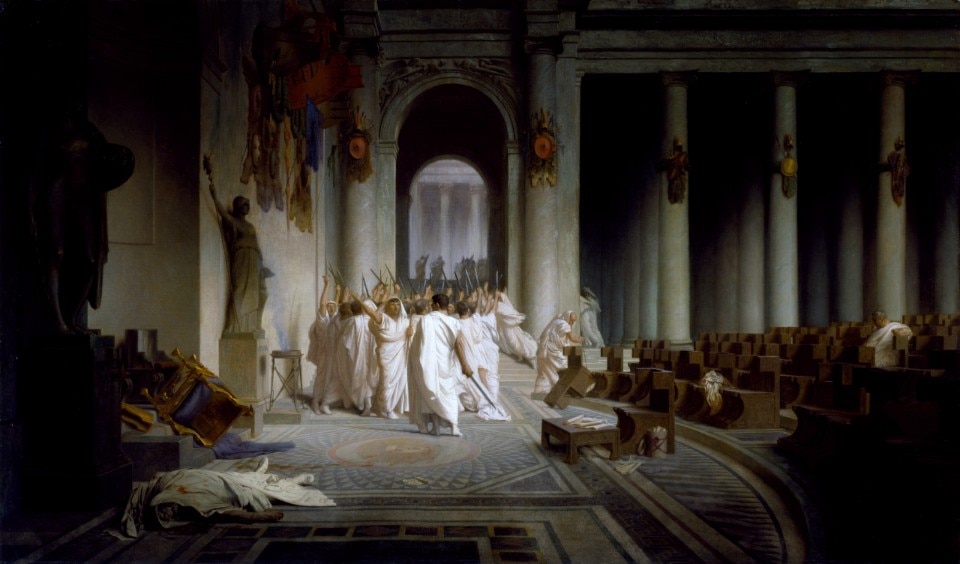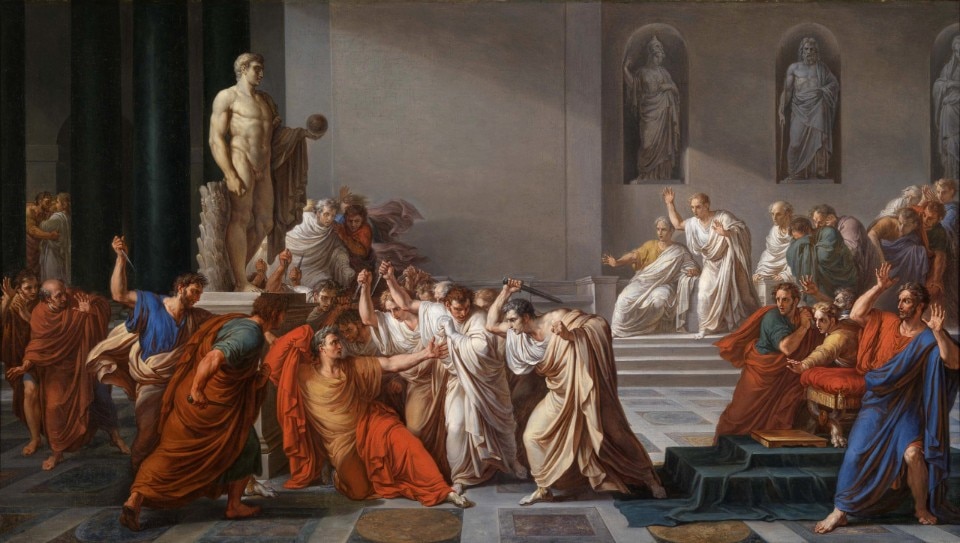‘The Ides of March.’ An expression that resonates through the centuries. In the temporal conception of ancient Romans, the Ides represented the midpoint of the month, the full moon day or the one immediately following it.
In 44 B.C., the March sun dimly illuminated the Curia of Pompey, where the Roman Senate convened in an atmosphere of tense calm. Among the senators, Julius Caesar, the victorious military leader and perpetual dictator, sat impassively.
Brutus and Cassius exchanged determined glances. Their plan was simple but bold: they would assassinate Caesar during the session and restore the Republic. As Caesar listened distractedly to the speeches, a senator approached him with a scroll. It was a false message, a pretext to get close and strike. Decimus Brutus, one of the conspirators, detained Caesar for a moment, giving the others time to deliver the fatal blow.
On the right side of the painting, chaos, fear, uncertainty; the figures are portrayed unaware of the conspiracy, but above all, they seem to declare their innocence.
Caesar was stabbed 23 times. He fell to the ground. The Senate descended into chaos. The conspirators, shouting about regained freedom, fled from the temple, while Caesar’s lifeless body lay there.
On March 15th, 44 B.C., Julius Caesar died, uttering these words: ‘Tu quoque, Brute, fili mi’ (You too, Brutus, my son).
The story of this day has reached us through the works of two important historians and biographers: Suetonius, author of De vita Caesarum (commonly known as The Twelve Caesars), and the Greek historian Plutarch, who wrote Parallel Lives.
Vincenzo Camuccini (Rome, 1771-1844), a painter favored by Popes and powerful figures, a neoclassical artist who brought to life the glories and tragedies of ancient Rome, interpreted the events through a colossal painting, now preserved at the Capodimonte Museum in Naples: The Death of Julius Caesar.
The dim light of the sunset filters through the windows of the Senate, illuminating the scene with powerful dramatic intensity, almost theatrical. Shadows stretch across the floor, creating a play of light and dark that heightens the tension of the moment. The white togas of the senators, the red garments, the rhythmic swords, the figures moving rhythmically across the entire canvas, perfectly articulate the narrative. The emotional scale is recreated by the bodies and arms of the figures. The plastic and statuesque poses of the characters confer solemnity to the moment.
On the right side of the painting, chaos, fear, uncertainty; the figures are portrayed unaware of the conspiracy, but above all, they seem to declare their innocence. On the left, in the central group, Caesar appears proud and strong, ready to succumb but with honor. He is surrounded, on the brink of death, yet he is not discomposed; on the contrary, he appears elegant, majestic, retaining his laurel crown upon his head.

A few years later, another neoclassical painter, Jean-Léon Gérôme (Vesoul, 1824 - Paris, 1904), recounted the assassination of Caesar in the painting The Death of Caesar.
Once again, the scene unfolds inside the Roman Senate. The statue of Pompey, on the shadowed left side, symbolizes the decline of the Republic. Caesar, covered by a white toga, lies at the foot of the Curia. His figure, lying limp and inert, almost concealed, creates a stark contrast with the agitation of the senators gathered in a circle at the center of the scene. He is no longer the focus but rather his enemies, the traitors.
The composition is meticulously crafted, with the architecture and the skillful use of light and shadow adding further dramatic intensity to the scene. Catastrophe, tragedy, suspense.
The painting was created during a period of great political fervor in France, shortly after the assassination of Napoleon III. Gérôme possibly wanted to create a parallel between the two events. Some critics have seen in the painting a condemnation of regicide, while others have interpreted it as a homage to freedom and democracy.
Plutarch wrote in Parallel Lives: ‘Therefore as portrait-painters are more exact in the lines and features of the face in which the character is seen, than in the other parts of the body, so I must be allowed to give my more particular attention to the marks and indications of the souls of men, and while I endeavor by these to portray their lives, may be free to leave more weighty matters and great battles to be treated of by others.’
The Ides of March have arrived.
Opening image: Vincenzo Camuccini, The Death of Julius Caesar, 1806 ca.


